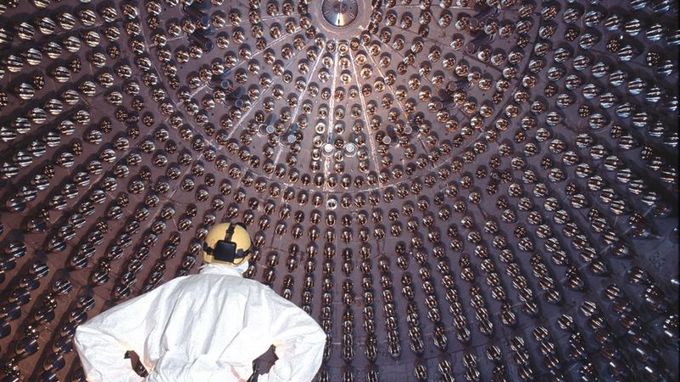Erster Gesamtblick auf die Fusionsprozesse der Sonne
Borexino-Experiment: Analyse der Neutrino-Signale aus zehn Jahren
2018-10-25 – Nachrichten aus dem Physik-Department

Warum scheint die Sonne? Wie produziert die Sonne ihre riesigen Energiemengen? Vor etwa hundert Jahren mutmaßten Physiker erstmals, dass diese Energie aus der Fusion von Atomkernen stammen müsse. Inzwischen beschreibt das so genannte Standard-Sonnenmodell, wie sich die Wissenschaft die Vorgänge in der Sonne erklärt, bei denen Temperatur, Druck und chemische Zusammensetzung eine wichtige Rolle spielen.
Die Sonne emittiert Neutrinos charakteristischer Energien
Etwa 99 Prozent der Sonnenenergie entstammen dem Modell zufolge aus einer Abfolge von Fusionsprozessen, bei der Wasserstoff zu Helium umgewandelt wird. Diese Abfolge startet mit der Verschmelzung zweier Protonen zu einem schweren Wasserstoffkern, daher auch pp-Kette genannt. Dabei wandelt sich eines der beiden Protonen in ein Neutron um und emittiert ein Positron und ein Neutrino.
Nach weiteren Wechselwirkungen wird schließlich Beryllium-7 produziert, das nach weiteren Einfängen schlussendlich in zwei Helium-Kerne zerfällt. Bei einigen dieser Prozesse werden auch Neutrinos charakteristischer Energien freigesetzt, so dass sich der Verlauf der pp-Kette genau rekonstruieren lässt.
Erste Gesamtaufnahme des Neutrino-Spektrums der Sonne
Das Experiment Borexino, tief unter den Bergen des italienischen Gran Sasso-Massivs, ist seit 2007 in Betrieb und darauf spezialisiert, diese solaren Neutrinos zu detektieren. Da Neutrinos sehr flüchtige Elementarteilchen sind und nur selten mit Materie wechselwirken, muss ein Neutrino-Detektor groß und der Beobachtungszeitraum lang sein, um genügend Signale zu erhalten.
Nun legen die Wissenschaftlerinnen und Wissenschaftler des Borexino-Experiments erstmals eine Gesamtuntersuchung der Fusionsvorgänge der pp-Kette mittels Neutrinos vor. Sie bestimmten dabei die Wechselwirkungsraten der einzelnen Prozesse mit bisher nicht erreichter Präzision. Zum ersten Mal konnten die Wissenschaftler außerdem nachweisen, dass neben Neutrinos aus dem pp- auch solche aus dem wesentlich selteneren pep-Prozess auf der Erde ankommen.
Die Ergebnisse bestätigen das Sonnenmodell
„Die Ergebnisse bestätigen insgesamt unsere theoretischen Vorstellungen von den Vorgängen im Inneren der Sonne“, sagt Stefan Schönert, Professor für Astroteilchenphysik, Co-Sprecher des Sonderforschungsbereichs 1258 an der Technischen Universität München und Mitglied des neuen ORIGINS Clusters. „Da Neutrinos mit nahezu Lichtgeschwindigkeit unterwegs sind und die Erde nach etwa acht Minuten erreichen, sehen wir mit Borexino in Echtzeit die Fusionsprozesse im Inneren der Sonne, die die Energie freisetzt.“
Die Borexino-Wissenschaftler berechneten auch die Energieproduktionsrate der Sonne und verglichen diese mit der gut bekannten Abschätzung auf Basis der elektromagnetischen Strahlung der Sonne. Beide Werte stimmen im Rahmen der Fehlergenauigkeit sehr gut überein und bestätigen wiederum das Sonnenmodell.
Bedenkt man, dass das Sonnenlicht im Gegensatz zu den Neutrinos etwa hunderttausend Jahre benötigt, um aus der Produktionszone im Inneren an die Sonnenoberfläche zu gelangen, zeigt sich, dass die Sonnentätigkeit seit mindestens hunderttausend Jahren unverändert ist.
Wie ist die chemische Zusammensetzung der Sonne?
Die Borexino-Ergebnisse geben auch einen interessanten Hinweis auf ein bisher nicht gelöstes Sonnenrätsel: Wie hoch ist die Konzentration an Kernen schwerer als Wasserstoff und Helium? Die Antwort, ob dieser Anteil hoch ist (1,8%) oder niedrig (1,3%), ist von großer Bedeutung: Je höher die Konzentration schwerer Kerne, desto mehr Licht wird absorbiert. Das hat Einfluss auf Temperatur, Größe, Helligkeit und Lebensdauer der Sonne.
Die Sonne gilt bisher als ein Stern mit niedriger Metallizität, die verschiedenen experimentellen Befunde sind allerdings nicht eindeutig. „Die Ergebnisse von Borexino deuten auf ein Temperaturprofil der Sonne hin, welches eher auf eine hohe Metallizität hinweist“, fasst Prof. Lothar Oberauer von der Technischen Universität München und eines der Gründungsmitglieder des Borexino-Experiments zusammen.
Neue Erkenntnisse über die fundamentalen Eigenschaften der Neutrinos
Schließlich konnten die Wissenschaftler noch wichtige neue Erkenntnisse zu den Eigenschaften der Neutrinos selbst gewinnen. Neutrinos haben die Eigenart, auf ihrer Reise zwischen verschiedenen Neutrino-Familien hin und her zu wechseln. Diese so genannte Neutrino-Oszillation hängt davon ab, ob sich ein Neutrino durch Vakuum oder durch Materie, etwa das dichte Sonneninnere, bewegt.
Mit der nun vorliegenden Analyse kann die Transformation der Neutrinos in Materie besser beschrieben werden und erweitert daher die Erkenntnisse über die fundamentalen Charakteristika dieser Elementarteilchen.
Veröffentlichung
Weitere Informationen
Das Experiment Borexino wird von einem internationalen Konsortium betrieben und finanziert. In Deutschland sind neben der Technischen Universität München das Institut für Kernphysik des Forschungszentrums Jülich, das Institut für Experimentalphysik der Universität Hamburg, die RWTH Aachen, der Exzellenzcluster PRISMA und das Institut für Physik der Johannes Gutenberg-Universität Mainz und die Physik-Fakultät der Technischen Universität Dresden beteiligt.
Das Borexino-Programm wird finanziert mit Mitteln des INFN (Italien), des NSF (USA), des Bundesministeriums für Forschung, der Deutschen Forschungsgemeinschaft, der Helmholtz-Gemeinschaft Deutscher Forschungszentren und der Max-Planck-Gesellschaft (Deutschland), der RFBR, der RSF (Russland) und des NCN (Polen).
Verwandte Meldungen
- EU-Förderung für wegweisende Projekte – 2018-04-19
- GERDA-Experiment: Beste Aussichten für den Nachweis eines extrem seltenen radioaktiven Zerfalls – 2017-04-06
- Stefan Schönert wird Fellow am Max-Planck-Institut für Physik – 2016-02-01
- Dunkle Materie: Mit CRESST auf der Suche nach Leichtgewichten – 2015-09-08
- Borexino-Ergebnisse sind einer der Top-10 “Breakthroughs” des Jahres – 2014-12-19
Links
- Arbeitsgruppe Schönert
- 10 years of borexino (englisch)
- Nature news and views: Solar neutrinos reveal how the Sun shines (englisch)
